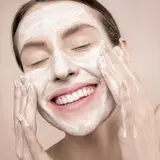
From Quick Rinses to Luxurious Rituals: The Evolution of Face Washing

For optimal skin health, one must establish a consistent cleansing routine. At a minimum, we recommend washing your face twice daily with lukewarm water, using a gentle cleanser that suits your skin type. The contemporary recommendation is to avoid hot water, out of concern that it might strip your skin of its natural oils, but we have noticed that our vintage guides largely advise us to use very hot water. In either case, always remove makeup before bed in order to prevent breakouts. After cleansing, moisturize to keep your skin hydrated. Over-washing or scrubbing can irritate your skin, so choose a gentle cleanser that respects your skin's natural barrier.
The exact technique of washing the face, however, requires more detailed guidance. Most of us will simply rub a cleanser on our face and rinse it off, but our foremothers took their time to massage the skin thoroughly. Below is a detailed description of this process; it is long, so grab a cup of tea and take the time to read carefully:
How to Wash the Face
It is much better, in cleansing the face, to use the hands and the fingers, for the touch of skin to skin has something peculiarly beneficial. To wash the face, then, let the water be hot and, dipping the hands into the bowl, make them soapy with the chosen soap, care being taken that this is of the best quality and such as agrees with the skin; then the hands should be applied to the face after a regular manner, systematically, using a kind of light facial massage. Dash the water over the face at first, then begin, using the four fingers of both hands, pass them from the middle of the forehead outward with firm pressure and let them rest lightly as they are brought back again; do this several times, thus smoothing out the vertical wrinkles.
Next, placing the fingers at the roots of the hair, bring the fingers down to the eyebrows, and as this is repeated several times let the fingers rest lightly on the skin with the upward stroke but exert considerable pressure on the downward stroke, as when the forehead is wrinkled the muscles contract from above. Let the three fingers slide up and down on each temple. Supporting the hands by the forefinger of each hand resting on each temple, use the second and third fingers to pass around in a revolving fashion about the rings of bone which form the outer edges of the sockets of the eyes, using the inner angle of the eye by the nose as the point of departure, and alternating the direction.
The eyes being closed, the eyelids are massaged, and the eyeballs themselves should be carefully rubbed, the forefinger being used for this. Next, supporting the hands by resting a thumb on the lower part of each cheek, use the first and second fingers of each hand to scrub the nose. Probably owing to its prominence and because it is more liberally supplied with oily glands than any other part of the face, it is much more difficult to keep the skin of the nose cleansed and free from blackheads than any other part, so the fingers should be very active and sympathetic in the task of washing this feature. The greatest pressure should be used in the downward stroke, and the pulpy part of the middle finger should be searching in its work about the nostrils. The cheeks are washed with the palms of the hands. The hands should be applied to the sides of the face with the fingers upward, the lower part of the hand resting on the bones of the lower jaw.
Great care should be taken in using the up and down scrubbing motion to make the pressure heavy on the upward stroke, but very light on the downward, as the tendency of the flesh of the cheeks is to sag as the years pass. Placing the thumbs under the chin for support, the first and second fingers are used to make a circular motion about the mouth, the fingers of each hand describing a semicircle and meeting the other in the middle. With the thumbs remaining in the same position under the chin, the forefinger of either hand may be employed to wash and massage the chin, which is done with a circular motion.
Lastly, the neck and chin are washed. Clasp the back of the neck with both hands so that the fingers touch, then bring the hands forward and down until the fingertips meet in front. That will bring the back of the hand to the chin on each side. The four fingers are flattened and spread against the chin and in the backward sweep lift the flesh against the jaw and smooth it out with considerable pressure.
It does not take long to acquire and execute the movements here explained, and if done habitually as one washes the face they will be of vastly more benefit than any general massage given at long and irregular intervals by a professional. In drying the face a soft, absorbing towel should be used. The action of the fingers in washing the face should have brought the blood freely and fully to every part, so that a coarse, harsh towel is not necessary. If the face is not thoroughly dried, the skin will become rough. It is important that the soap which has been used should be thoroughly rinsed from the face before drying.
In summary: use your hands for facial cleansing, as the touch of skin to skin offers unique benefits. Allow us to de-influence you from buying various brushes, scrubs, and devices for cleansing the skin. Your hands are the ideal tool. As these instructions indicate, begin with hot water (ideally) and a high-quality soap. Gently massage your face using your fingertips, starting with the forehead and moving to every zone of the face: the eyes, nose, cheeks, chin, and neck. Apply firm pressure on upward strokes and lighter pressure on downward strokes to avoid sagging. And pay close attention to the nose, as it is prone to blackheads. Thoroughly rinse away all soap, and gently pat your face dry with a soft towel. This meticulous approach, if practiced consistently, will yield better results than occasional professional facials and massages.
We can still appreciate the importance of certain cultural (and personal) priorities. Self-care and skincare routines continue to fascinate us, as they have become significant aspects of modern wellness culture. But even at the turn of the 20th century, women recognized the importance of selecting high-quality products suited to individual needs; much of our modern skincare is also based on prioritizing customized skincare solutions.
You will find a wealth of content on social media explaining the nuances of facial massage and facial exercises. There is no need to make things complicated or buy an online course; the guide that we are featuring here is thorough enough, and aligns with our modern beauty standards, which value not only hygiene, but preventative measures against aging. The holistic beauty practices that many of us embrace today mirror the vintage focus on maintaining healthy skin through daily practice.
We should also take a moment to appreciate the slow, intentional approach to personal care that we find in this text, in contrast to the fast-paced nature of our modern life. The appeal to deliberate attention to oneself echoes the broader movements towards mindfulness that we so desperately need; taking a few minutes to thoroughly care for our skin encourages us to make time for rituals that promote relaxation and self-appreciation amidst the stresses of 21st century life.
These instructions come from The Fountain of Youth, or Personal Appearance and Personal Hygiene, published in 1905.